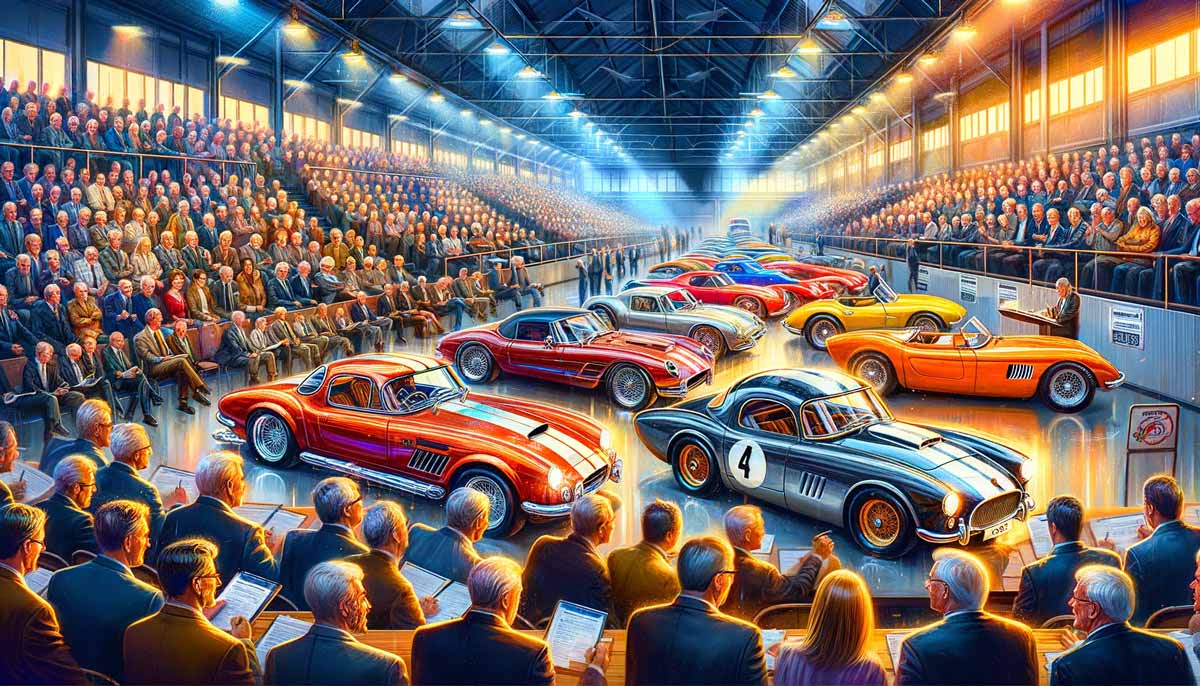 https://auction.ridesafely.com/images/2025/12/do-auction-cars-have-clean-titles-guide-banner.jpg
865
1440
RideSafely
/images/2025/01/ridesafely-logo.svg
RideSafely2025-12-18 12:20:002025-12-18 14:40:43Do Auction Cars for Sale Come With Clean Titles?
https://auction.ridesafely.com/images/2025/12/do-auction-cars-have-clean-titles-guide-banner.jpg
865
1440
RideSafely
/images/2025/01/ridesafely-logo.svg
RideSafely2025-12-18 12:20:002025-12-18 14:40:43Do Auction Cars for Sale Come With Clean Titles?Rediscovering Classics: The Vintage Car Experience
Vintage cars are more than just modes of transportation; they’re rolling pieces of art and history. These vehicles offer a unique driving experience, a sense of nostalgia, and a ticket to an exclusive community of enthusiasts. In this comprehensive guide, we’ll explore the joys and perks of owning a vintage car, the practical aspects of maintenance and insurance, and the undeniable charm that these timeless beauties possess.
The Unmatched Driving Experience of Vintage Vehicles
Driving a vintage car is about feeling the road, understanding the machine, and appreciating the craftsmanship of a bygone era. Unlike modern vehicles, vintage cars provide a hands-on driving experience that’s becoming increasingly rare. The tactile feedback from the steering wheel, the sound of the engine, and the manual gear shifts make for an exhilarating experience. It’s a return to the roots of motoring, where the driver is directly connected to the mechanics of the vehicle.
Ease of Maintenance: A DIY Enthusiast’s Dream
One of the most appealing aspects of vintage cars is their simplicity. With less reliance on complex electronics, many older cars can be maintained and repaired by the owners themselves. This not only adds a personal touch to the ownership experience but can also be a cost-effective way to keep your classic car running. Enthusiasts often find joy in tinkering with their vehicles, making adjustments, and learning about the inner workings of their automotive treasures. In fact, the 2024 RideSafely Builder Showdown is an excellent opportunity for DIY enthusiasts to showcase their skill and creativity in car restoration and customization, making it an event not to be missed by vintage car lovers.
Affordability in Insurance and Operation
Contrary to popular belief, owning a vintage car can be financially viable. Many insurance companies offer specialized classic car insurance policies that are surprisingly affordable, especially when considering that these vehicles are often used less frequently and maintained meticulously. Additionally, some vintage models are known for their impressive fuel efficiency, which can be a pleasant surprise for new owners. However, it’s important to budget for potential maintenance and the cost of rare spare parts.
The Status Symbol: Vintage Cars as a Fashion Statement
Owning a vintage car is about making a statement. Whether it’s a sleek Cadillac, a charming Volkswagen Beetle, or a majestic Jaguar, each vehicle has its own character and style. These cars turn heads, start conversations, and often become the centerpiece of any gathering they grace. Driving a vintage car is not just about getting from point A to point B; it’s about doing so with flair and elegance.
Making the Dream a Reality: Acquiring Your Vintage Treasure
The journey to owning a vintage car can be as exciting as driving one. Research is key – from understanding the specific model’s history to knowing its market value. Websites specializing in classic cars can be invaluable resources for potential buyers. Moreover, the option of sharing the cost with a friend or relative for a joint venture can make the dream more attainable. Auctions, both online and in-person, are excellent places to start your search for the perfect vintage car.
Enhancing Your Vintage Car’s Performance and Aesthetics
Owning a vintage car is not just about preserving its original state; it’s also about enhancing its performance and aesthetics according to modern standards while respecting its historical integrity. Many owners choose to upgrade certain parts of their vehicles, like installing more efficient braking systems or better-performing engines. These enhancements can make driving a vintage car a more enjoyable and safe experience. Additionally, aesthetic improvements, such as high-quality paint jobs or interior restorations, can significantly increase a car’s visual appeal and value.
The Community and Cultural Aspect of Vintage Car Ownership
Vintage car owners often find themselves part of an enthusiastic community. Clubs and organizations dedicated to specific car models or eras offer a platform for owners to share their passion, knowledge, and experiences. Attending car shows, rallies, and meet-ups can be a delightful way to connect with other enthusiasts and showcase your prized possession. Furthermore, vintage cars often feature in films, television shows, and cultural events, underlining their significant role in popular culture and history.
Environmental Considerations and Vintage Cars
While vintage cars have a unique appeal, they also pose environmental considerations, particularly regarding emissions and fuel efficiency. Environmentally conscious owners often explore options like engine modifications or using cleaner fuels to reduce the environmental impact of their vehicles. Balancing the car’s historical authenticity with modern environmental standards is a challenge that many vintage car enthusiasts are willing to undertake.
Investment Potential of Vintage Cars
Vintage cars can be more than just a hobby; they can also be a wise investment. Certain models and makes have shown remarkable appreciation in value over the years. However, it’s essential to conduct thorough research and seek expert advice when considering a vintage car as an investment. Factors such as rarity, condition, originality, and historical significance play crucial roles in determining a car’s investment potential.
In Conclusion: The Timeless Allure of Vintage Cars
Vintage cars offer a unique blend of history, style, and personal satisfaction. They connect us to the past, bring joy in the present, and become cherished heirlooms for the future. Whether you’re a seasoned collector or a newcomer to the world of classic automobiles, the allure of a vintage car is undeniable. It’s more than just a hobby; it’s a lifestyle that celebrates the rich heritage of automotive history. For those looking to embark on this exciting journey, RideSafely offers a vast selection of vintage and classic cars, providing a gateway to owning a piece of automotive history.
Expert Insights: Your Essential FAQ Guide to Vintage Car Ownership
What defines a car as "vintage" or "classic"?
A vintage car typically refers to vehicles manufactured between 1919 and 1930, while classic cars are usually defined as vehicles over 20 years old but not older than 40 years. However, these definitions can vary among enthusiasts and organizations.
How do I start my journey into vintage car ownership?
Begin by researching the types of vintage cars that interest you, considering factors like model history, maintenance requirements, and your budget. Joining forums and clubs can provide valuable insights and connections in the vintage car community.
What are the typical costs associated with owning a vintage car?
Costs include the initial purchase price, regular maintenance, possible restoration costs, insurance, and storage. Vintage cars may require more frequent upkeep, and parts can be costly or hard to find.
How can I ensure that my vintage car is environmentally friendly?
Consider modifications like upgrading to a more efficient engine, using cleaner fuels, or implementing electric vehicle (EV) conversions specifically designed for vintage cars.
Can vintage cars be a good investment?
Yes, certain vintage cars have appreciated in value over time. Factors affecting investment potential include rarity, model desirability, historical significance, and condition. However, investment should not be the only reason for purchase, as market trends can vary.
What are the best ways to maintain and preserve a vintage car?
Regular maintenance is key. Store the car in a dry, climate-controlled environment, regularly check and change fluids, and address any rust or mechanical issues promptly. Periodic driving helps keep the car in good working order.
Are there any specific insurance requirements for vintage cars?
Vintage cars often qualify for specialized classic car insurance, which can be more affordable than standard policies. Requirements may include limited mileage, secure storage, and using the car as a secondary vehicle.
How can I modify my vintage car without losing its classic charm?
Focus on reversible modifications that improve safety and performance, like brake upgrades or electronic ignition systems. Avoid extensive modifications that alter the car’s original design and character.
Where can I find a community of vintage car enthusiasts?
Local and online vintage car clubs, automotive forums, and social media groups are great places to connect with fellow enthusiasts. Car shows, auctions, and rallies also offer opportunities to meet and learn from others.
What should I consider when choosing a vintage car for restoration?
Evaluate the car’s overall condition, availability of replacement parts, and your ability to perform or fund restorations. Consider if the model has historical significance or personal value to you, and whether you have the space and tools needed for the project.






Leave a Reply
Want to join the discussion?Feel free to contribute!